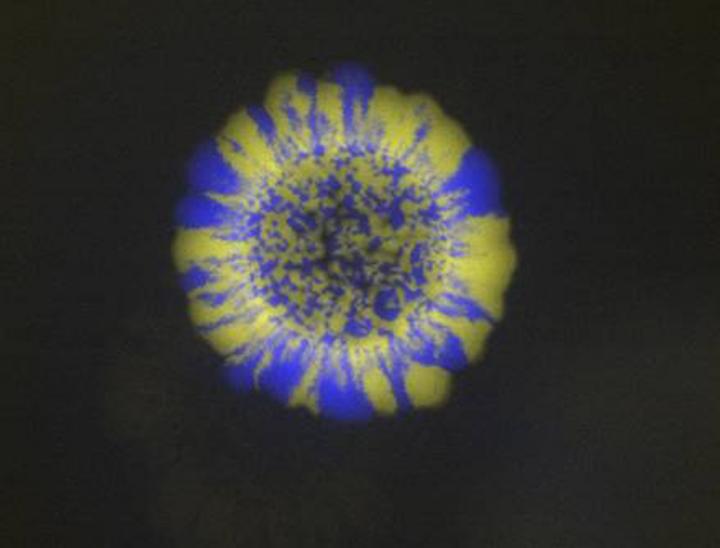New mechanism to fight multi-resistant bacteria revealed

These are E. coli bacteria with different antibiotic resistances (in yellow and blue) evolving. Credit: Jorge Sousa, IGC.
As spread of multi-drug resistant bacteria increases, it is important to understand how are they being maintained in populations. Antibiotics target essential bacteria cellular functions. However, bacteria can evolve and become resistant to these drugs by acquiring mutations in genes involved in those functions.
This comes at a cost for bacteria, as most drug resistant mutations are prejudicial in the absence of the antibiotic. To overcome this, bacteria can acquire additional compensatory mutations. How these compensatory mutations evolve in multi-drug resistant bacteria was completely unknown, and was what Isabel Gordo's team proposed to study now.
Previous results from Isabel Gordo's laboratory showed that genetic interactions between resistance mutations are frequent and are the driver for multi-resistance. Now, the researchers showed that the pace of the compensatory adaptation in multi-drug resistant Escherichia coli (E. coli) strains is faster than for strains carrying a single resistance mutation.
Most importantly, they were able to identify the key proteins involved in the compensatory mechanism of multi-drug resistant bacteria. These results came from the analysis of E. coli strains with single resistance to rifampicin and to streptomycin antibiotics, and strains with resistance to both antibiotics, grown in antibiotic-free media.
“If we use a very simplistic metaphor and compare bacteria with a car, we would say that many mutations that confer resistance to streptomycin affect the motor of the cell that drives the production of proteins (the ribosome), whereas resistances to rifampicin come from mutations in the accelerator of that motor (a protein called RNA polymerase).
We now discovered that the compensatory mechanism of multi-drug resistant E. coli encompasses mutations in the 'clutch', i.e. in proteins that link the cell's 'motor' with the 'accelerator'”, explains Isabel Gordo. The IGC researcher further adds: “If we can block the proteins now identified we may be able to kill multi-drug resistant bacteria, since we would be eliminating this compensatory mechanism that favours their growth in the population.”
The research team predicts that the mechanism now discovered might be generally used in several other multi-drug resistances, since antibiotics target the same cellular mechanisms. Hence, the proteins now identified can be good candidate targets for the design of therapies against multi-drug resistant bacteria.
###
This study was conducted at Instituto Gulbenkian de Ciência and funded by European Research Council and the Fundação para a Ciência e a Tecnologia (Portugal).
*Moura de Sousa J, Balbontin R, Durão P, Gordo I (2017) Multidrug-resistant bacteria compensate for the epistasis between resistances. PLoS Biol 15(4): e2001741. https:/
Media Contact
All latest news from the category: Life Sciences and Chemistry
Articles and reports from the Life Sciences and chemistry area deal with applied and basic research into modern biology, chemistry and human medicine.
Valuable information can be found on a range of life sciences fields including bacteriology, biochemistry, bionics, bioinformatics, biophysics, biotechnology, genetics, geobotany, human biology, marine biology, microbiology, molecular biology, cellular biology, zoology, bioinorganic chemistry, microchemistry and environmental chemistry.
Newest articles

Superradiant atoms could push the boundaries of how precisely time can be measured
Superradiant atoms can help us measure time more precisely than ever. In a new study, researchers from the University of Copenhagen present a new method for measuring the time interval,…

Ion thermoelectric conversion devices for near room temperature
The electrode sheet of the thermoelectric device consists of ionic hydrogel, which is sandwiched between the electrodes to form, and the Prussian blue on the electrode undergoes a redox reaction…

Zap Energy achieves 37-million-degree temperatures in a compact device
New publication reports record electron temperatures for a small-scale, sheared-flow-stabilized Z-pinch fusion device. In the nine decades since humans first produced fusion reactions, only a few fusion technologies have demonstrated…





















